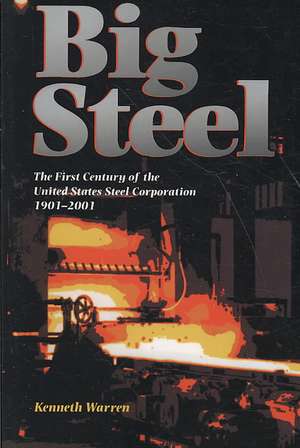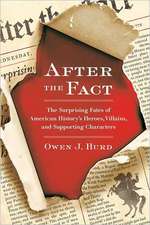Big Steel: The First Century of the United States Steel Corporation 1901-2001
Autor Kenneth Warrenen Limba Engleză Paperback – 29 feb 2008
At its formation in 1901, the United States Steel Corporation was the earth’s biggest industrial corporation, a wonder of the manufacturing world. Immediately it produced two thirds of America’s raw steel and thirty percent of the steel made worldwide. The behemoth company would go on to support the manufacturing superstructure of practically every other industry in America. It would create and sustain the economies of many industrial communities, especially Pittsburgh, employing more than a million people over the course of the century.
A hundred years later, the U.S. Steel Group of USX makes scarcely ten percent of the steel in the United States and just over one and a half percent of global output. Far from the biggest, the company is now considered the most efficient steel producer in the world. What happened between then and now, and why, is the subject of Big Steel, the first comprehensive history of the company at the center of America’s twentieth-century industrial life.
Granted privileged and unprecedented access to the U.S. Steel archives, Kenneth Warren has sifted through a long, complex business history to tell a compelling story. Its preeminent size was supposed to confer many advantages to U.S. Steel—economies of scale, monopolies of talent, etc. Yet in practice, many of those advantages proved illusory. Warren shows how, even in its early years, the company was out-maneuvered by smaller competitors and how, over the century, U.S. Steel’s share of the industry, by every measure, steadily declined.
Warren’s subtle analysis of years of internal decision making reveals that the company’s size and clumsy hierarchical structure made it uniquely difficult to direct and manage. He profiles the chairmen who grappled with this “lumbering giant,” paying particular attention to those who long ago created its enduring corporate culture—Charles M. Schwab, Elbert H. Gary, and Myron C. Taylor.
Warren points to the way U.S. Steel’s dominating size exposed it to public scrutiny and government oversight—a cautionary force. He analyzes the ways that labor relations affected company management and strategy. And he demonstrates how U.S. Steel suffered gradually, steadily, from its paradoxical ability to make high profits while failing to keep pace with the best practices. Only after the drastic pruning late in the century—when U.S. Steel reduced its capacity by two-thirds—did the company become a world leader in steel-making efficiency, rather than merely in size.
These lessons, drawn from the history of an extraordinary company, will enrich the scholarship of industry and inform the practice of business in the twenty-first century.
A hundred years later, the U.S. Steel Group of USX makes scarcely ten percent of the steel in the United States and just over one and a half percent of global output. Far from the biggest, the company is now considered the most efficient steel producer in the world. What happened between then and now, and why, is the subject of Big Steel, the first comprehensive history of the company at the center of America’s twentieth-century industrial life.
Granted privileged and unprecedented access to the U.S. Steel archives, Kenneth Warren has sifted through a long, complex business history to tell a compelling story. Its preeminent size was supposed to confer many advantages to U.S. Steel—economies of scale, monopolies of talent, etc. Yet in practice, many of those advantages proved illusory. Warren shows how, even in its early years, the company was out-maneuvered by smaller competitors and how, over the century, U.S. Steel’s share of the industry, by every measure, steadily declined.
Warren’s subtle analysis of years of internal decision making reveals that the company’s size and clumsy hierarchical structure made it uniquely difficult to direct and manage. He profiles the chairmen who grappled with this “lumbering giant,” paying particular attention to those who long ago created its enduring corporate culture—Charles M. Schwab, Elbert H. Gary, and Myron C. Taylor.
Warren points to the way U.S. Steel’s dominating size exposed it to public scrutiny and government oversight—a cautionary force. He analyzes the ways that labor relations affected company management and strategy. And he demonstrates how U.S. Steel suffered gradually, steadily, from its paradoxical ability to make high profits while failing to keep pace with the best practices. Only after the drastic pruning late in the century—when U.S. Steel reduced its capacity by two-thirds—did the company become a world leader in steel-making efficiency, rather than merely in size.
These lessons, drawn from the history of an extraordinary company, will enrich the scholarship of industry and inform the practice of business in the twenty-first century.
Preț: 464.44 lei
Nou
Puncte Express: 697
Preț estimativ în valută:
88.87€ • 95.03$ • 74.10£
88.87€ • 95.03$ • 74.10£
Carte tipărită la comandă
Livrare economică 17 aprilie-01 mai
Preluare comenzi: 021 569.72.76
Specificații
ISBN-13: 9780822960027
ISBN-10: 0822960028
Pagini: 424
Dimensiuni: 152 x 229 x 36 mm
Greutate: 0.65 kg
Ediția:1st Edition
Editura: University of Pittsburgh Press
Colecția University of Pittsburgh Press
ISBN-10: 0822960028
Pagini: 424
Dimensiuni: 152 x 229 x 36 mm
Greutate: 0.65 kg
Ediția:1st Edition
Editura: University of Pittsburgh Press
Colecția University of Pittsburgh Press
Recenzii
“Professor Warren brings forward a clear, well-argued and eminently fascinating account of the creation, growth, decline, and rebirth of US Steel, and does it in a way that I think will appeal not only to the academic experts, but will have a broad crossover appeal to general readers, and certainly to the large ‘business book’ market.”
—John N. Ingham, University of Toronto
—John N. Ingham, University of Toronto
“Warren brings forward a clear- well-argued and eminently fascinating account of the creation, growth and decline, and rebirth of U.S. Steel.”
—Western Pa. Genealogical Society Quarterly
—Western Pa. Genealogical Society Quarterly
Warren has “a fine grasp for the minutiae of geographic expansion and transportation costs in the industry, the size and kinds of steel-making cpacity additions, and the intricacies of raw material sourcing. . . . of much value as a guide to the outlines of the firm’s development.”
--Journal of American History
--Journal of American History
Notă biografică
Kenneth Warren is Emeritus Fellow of Jesus College, University of Oxford. He is the author of numerous books, including Wealth, Waste and Alienation: Growth and Decline in the Connellsville Coke Industry and Industrial Genius: The Working Life of Charles Michael Schwab.
Descriere
Big Steel is the first comprehensive history of the company at the center of America’s twentieth-century industrial life––the United States Steel Corporation. Granted unprecedented access to the U.S. Steel archives, Warren tells the compelling history of this business.










